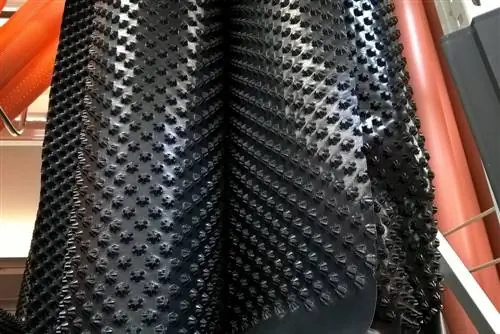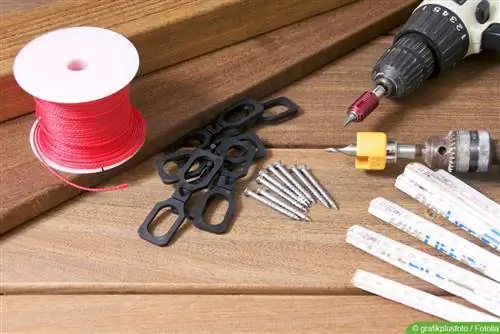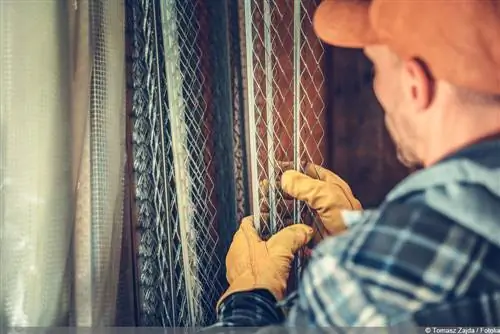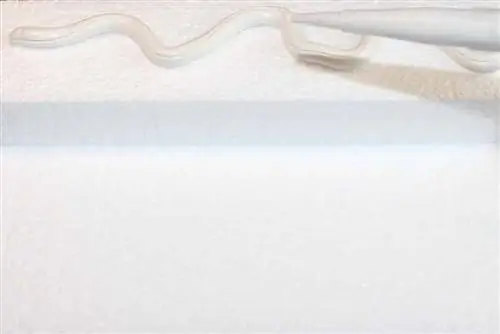- Author admin [email protected].
- Public 2023-12-17 03:39.
- Last modified 2025-06-01 06:48.
A dimpled membrane provides protection against moisture, can promote drainage and also create a ventilation level in the wall. In addition, it can not only be used to protect the cellar walls against groundwater and seepage, but can also be used, for example, to add greenery to the roof. But how can it be attached and what should you pay attention to? Our instructions and tips will provide information.
Features and Benefits
Masonry in contact with the earth - i.e. basement walls - is exposed to particularly high loads. Groundwater, seepage water and moisture from the earth can penetrate over time and weaken the building structure. To prevent this, dimpled sheets can be installed. These special films combine various advantages and properties. Below:
Drainage of water
The dimpled film can drain water via a drainage pipe.
Rear ventilation
Depending on the direction in which the bubble wrap is laid, a ventilation level can be created between the wrap and the wall. In addition, a distance is created between the so-called perimeter insulation and the ground.
Protection and sealing
Dimpled sheets also provide insulation when groundwater is pressurized. They protect the walls and seal them against moisture and moisture. This is particularly useful and important if there is a high groundwater level or a high volume of seepage water.
Making work easier
By attaching dimpled sheets, you can avoid using lean concrete. This eliminates the associated effort and the waiting time for the concrete to dry out. Weather-resistant work is possible. This can be a significant relief. In addition, the dimpled sheets can also be used for other purposes. For example, they can be used as an insulation layer on the roof if it is to be greened.
Preparations
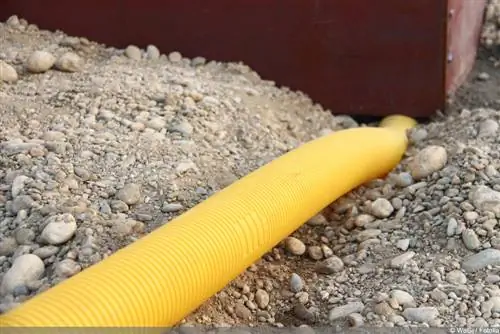
Before attaching the dimpled sheets, the surface must be prepared accordingly. In principle, only two steps are necessary:
-
Clean the foundation walls thoroughly
Dust, grease, moss and other dirt must be carefully removed. Any film residue that may be present should also be removed. It is also advisable to repair damage such as cracks or holes. Although repairing damage is not absolutely necessary before applying the film, the measure can significantly increase the hold and durability of the membranes.
-
Painting for preparation
Before attaching the dimpled sheets, the foundation walls need a coat of paint. This sealing coating is a bitumen coating. It acts as a waterproof and protective cover. However, it only offers security against non-pressing water. Once these preparations have been completed, you can begin attaching the dimpled sheets.
Attach and fasten
When attaching the film, various factors must be taken into account:
-
Direction
If the knobs point towards the wall, they ventilate the masonry. In addition, they don't get dirty themselves. If the knobs point outwards, greater structural mechanical protection is achieved. If drainage is required, the knobs on the film should point towards the ground. If no drainage is needed, they can point towards the structure.
-
Fleece
If the knobs point outwards, an additional fleece should be attached between the foil and the masonry. This makes sense so that the intermediate area does not become clogged and muddy. However, some dimpled sheets are already equipped with a filter fleece, so this additional step is no longer necessary. If the studs face the masonry, variants with sliding film are a good choice. These provide better protection.
-
Nails or snaps
The studded foils can be attached with both nails and press studs. The nails are driven into the nail edge of the foil. The snap fasteners are placed in the individual nubs. A third option for fastening is screws and dowels. The screws are also inserted directly into the studs. When it comes to attachment, nailing is the easiest.
-
Attaching
When attaching, pay attention to the alignment and distances. Two landmarks play a role here. The drainage pipe serves as the lower orientation point; the foil should be attached above it. The sealing coat serves as an upper reference point. The foil is placed about ten centimeters above it and fixed.
-
Alignment of the lanes
As a rule, the bubble wrap is laid horizontally. This simplifies installation and offers a high level of protection. In addition, cutting is much easier and requires less effort. However, vertical laying is also possible. This can be useful if only a smaller area needs to be covered with the film.
Attaching bubble wrap - step by step
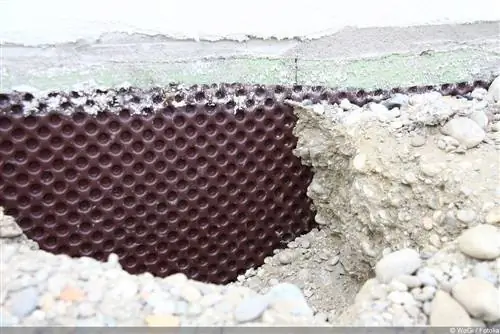
Attachment of the bubble wrap is very easy if the following steps are taken into account:
- Determine the landmarks using sealing paint and drainage pipe. It can be started from above or from below.
- Align the film directly from the roll on the wall and attach it using the material of your choice. This step works easiest if a helper holds the roll and unwinds it piece by piece.
- If the first strip is on the wall, the second dimpled strip is aligned so that the foils overlap by about ten centimeters. This is done until the area between the upper and lower orientation points is completely covered.
Due to the simple procedure, it is also possible for DIY enthusiasts with little experience to attach the foil strips themselves.
Costs for foil strips
The costs for dimpled sheets can vary greatly and depend on which version is chosen. Inexpensive standard sheets in a single-layer design are available for around 1.35 euros per square meter. They offer protection against groundwater and seepage water and form a layer of cleanliness.
High-quality variants consist of up to three layers, i.e. they are a ready-made combination of filter fleece, sliding film and the dimpled membrane itself. They also usually offer high compressive strength and can therefore be the better choice for heavily used areas. Up to 7.20 euros per square meter are due for them.

